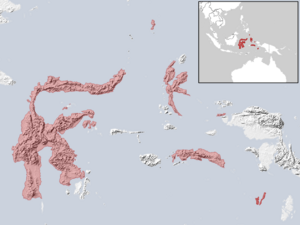Maluku myotis facts for kids
Quick facts for kids Maluku myotis |
|
|---|---|
| Conservation status | |
| Scientific classification | |
| Genus: |
Myotis
|
| Species: |
moluccarum
|
 |
|
The Maluku myotis (Myotis moluccarum) is a type of mouse-eared bat. It's also known as the Arafura large-footed bat. This bat lives in Indonesia, and possibly in New Guinea and northern Australia. It's special because it's one of several "fishing bats." It catches its food, like small fish, right off the water's surface using its big feet!
Contents
What Does the Maluku Myotis Look Like?
The Maluku myotis has big ears and large feet. The fur on its back is gray-brown or rusty. The fur on its belly is a cinnamon-brown color. Its wings are light brown.
An adult bat's forearm is about 4 cm (1.6 in) long. It weighs between 8 and 15 g (0.3 and 0.5 oz). That's about as much as a few grapes!
Where Does the Maluku Myotis Live?
The Maluku myotis is originally from Indonesia. You can find it on islands like Halmahera, Seram, Ambon, Peleng, and the Kai Islands.
Some people think it might also live in New Guinea and Australia. However, it's possible that bats seen there are actually a different species. They might be the southern or large-footed myotis, called Myotis macropus.
This bat likes to live in low-lying areas. It prefers wetlands, places around lakes, and near streams. It usually lives below 300 m (980 ft) in height, but can sometimes be found up to 1,200 m (3,900 ft).
Maluku Myotis Behaviour and Life Cycle
The Maluku myotis is a nocturnal animal. This means it is active at night. It hunts for food by flying low over the water. It uses its large feet to scoop up small fish and water insects.
During the day, these bats rest in safe places. They might roost in caves, tunnels, old mines, or abandoned buildings. You can also find them under bridges, in hollow trees, or under rocky overhangs.
Reproduction
Female Maluku myotis bats usually give birth to one baby at a time. Sometimes, they can have twins. They can have babies up to three times each year.
Is the Maluku Myotis in Danger?
Scientists are not completely sure about the exact places the Maluku myotis lives. They also don't know if its population is growing or shrinking. However, this bat is not rare in the areas where it lives.
Because of this, the International Union for Conservation of Nature (IUCN) says its conservation status is "least concern". This means it's not currently in danger of disappearing. The IUCN suggests that protecting the places where these bats rest during the day is important.


